Mustawd
Guest
Really glad you're making progress. Keep it up man!



For some reason, I didn't get the notification there was an answer to the thread, then got stuck on horrible holiday connection.I've read all pages just now, despite looking at the name of the topic frequently when reading this subforum. I was avoiding it because of the name. Zodiac Legion doesn't sound good to me, but I don't like the word zodiac as it is, so my opinion has little weight. The topic was very informative, really enjoyed some of your under the hood technical and mechanical stuff. Also, it was quite funny reading your (now quite old) analysis of 3D6 vs D20 here, and then going to the fresh Tyranny review topic and reading about the same damn thing there :D
I can't help myself but I have to drop by a small note regarding the problems with level building on hexes on the first page: looking how Fallout did it would help you. The basic wall tiles there are in 2 versions: one long for odd hexes and short ones for even hexes (or the other way around, depending on the axis). But it's too late now, whatever, you did it your way.
Ok, now back to the present. Art looks amazing, gameplay looks intriguing (just the fucking name, dammit :D). It may be the first kickstarter I will participate in.
Looks great! I didn't read all 10 pages up to here, but what I've seen is pretty impressive. How big is the team working on this? Can you tell us what your budget is like? Are you paying people through profit-sharing?
For the nighttime, darkness, moonlight, firelight issue, I'd like to make a suggestion: Give your characters another sprite layer for the 2D equivalent of built-in fresnel sidelighting:

Excuse the derp eyes. Not my pic.
I don't think it would be a huge amount of work. You could draw white pixels over the characters' edges, black everywhere else. And then in your levels you could have a lighting color, say orange when you're in firelight, that you multiply by the white pixels and draw over the top.
Or you could do things the RPG Maker way: When your character approaches a light, increase the contrast to wash out the highlights and darken the shadows, then multiply by the light's color.

Some names as tips for brainstorming or something: The Order of the Forbidden Sign, 13th Legion, Knights of the Devil's Dozen.I am open to a new name for the game. I am quite bad at naming, and I have been unconvinced by my daughter's suggestions so far, so any outside help would be appreciated
It was supposed to be some kind of homage to Saint Seiya (Knights of the Zodiac in French), because this anime was both cheesy and awesomely cool back in the day, but it was only popular in France (and Japan/Brazil), so it might not be so good a start.
Also, Knights of the Zodiac sounds better than Zodiac Legion to me.


and then I'll try to setup the AI to learn some things by itself

and then I'll try to setup the AI to learn some things by itself
You're pretty serious about making an AI opponent. I would be embarrassed to tell you what Himeko Sutori's AI does. What language is your game written in? Please tell me that at least you imported someone else's ML libraries. And I caught something about using GPU cycles. Are you using CUDA to parallelize ML on your GPU to train an AI to play your game? Either I read too deep into that, or you're absolutely insane. You're not also going to train your AI against each individual player are you?
My only experience with ML is in Python. To break up big datasets and parallelize the computations I used Spark. Overall it was pretty simple stuff I was doing: looking for relationships in data using off-the-shelf classifiers. I never got into neural nets or deep learning. That seems like a lot of work when you could probably just give your enemies hardcoded heuristics to follow and adjust enemy hp and damage output for difficulty. But if a tactically brilliant AI is what you're determined to get, I wish you the best of luck.



No way.Dead?

Who?Dead?

No, it isn't! What made you believe otherwise?
This project, I mean.
No, it isn't! What made you believe otherwise?
This project, I mean.
I still have work to do before I can post a gameplay video, and I am not very good at blogging, so there has been little update.

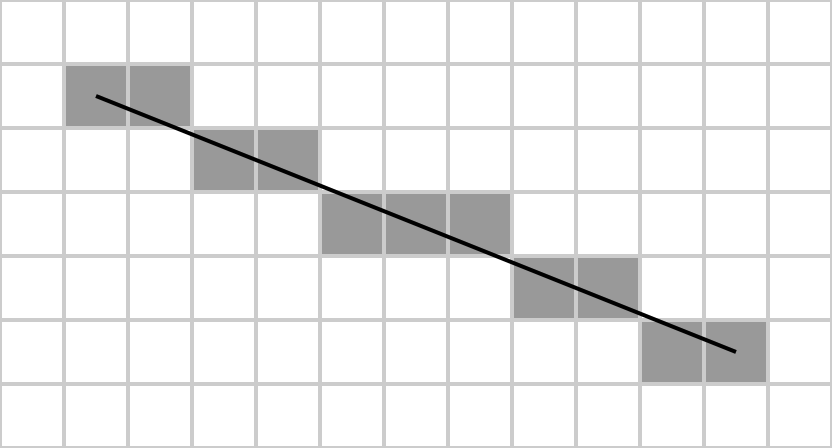

It is part of the problem with Bresenham indeed:Hmmmmm. That kinda algorithm could fake being random pretty good.



GETTING STARTED WITH MOAI
Date sam. 25 mars 2017 Tags development / technical / moai
WHY MOAI?
Before starting the development of Zodiac Legion, I had tried several ways of writing games, from programming a FPGA (it was a school project) to using high level languages on my TI-92 calculator, and complete frameworks.
I liked using a high level language, but reusing existing frameworks made it much easier to get things done in a timely manner. But it could also take quite a long time to circumvent the limitations of the engines, and waiting for other to fix bugs was not really an efficient way to move forward.
I also wanted an engine that would let me port easily from one platform to another.
So once I had decided to go 2D, I first tried working with Python, but distributing games made with it sounded like a pain.
Unity felt a bit "too heavy" (or obstrusive) for my needs. I have always preferred lighter frameworks. So I made some research, and I discovered moai. A few simple prototypes later, I had fallen in love with the engine, and lua.
MADE WITH MOAI
At this time, there were several big indie developers using it, like Double Fine for Broken Age:
"We used Moai for the first time during our last Amnesia Fortnight," said Nathan Martz, tech director at Double Fine.
"We wanted to experiment with some 2d games and some mobile games, and Moai jumped out at us as a really simple, lightweight, quick to get into technology."
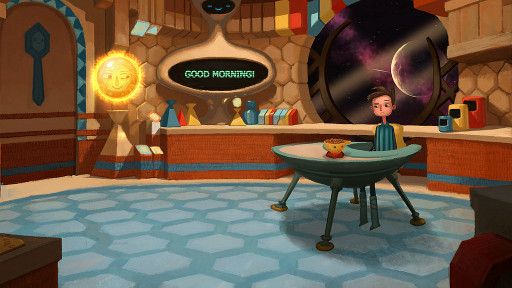
Broken Age, one of the bigest moai projects, by Double Fine Studios
You can read about the 12 weeks development of Crimson:Steam Pirates with moai on gamasutra:
"The Crimson team at Harebrained Schemes is made up of 7 people at its peak, and we had a total development cycle of just 12 weeks. We were able to pull this off due to a few key things:
A clear creative vision Experienced developers and artists, 99% of the game was built in Lua script using an open source game development platform called Moai."
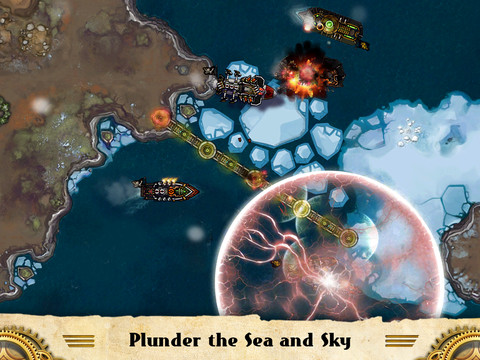
Crimson Steam Pirates by Harebrained Schemes, the guys behind Shadowrun Returns
More recently, Klei has also chosen moai to develop Invisible Inc.
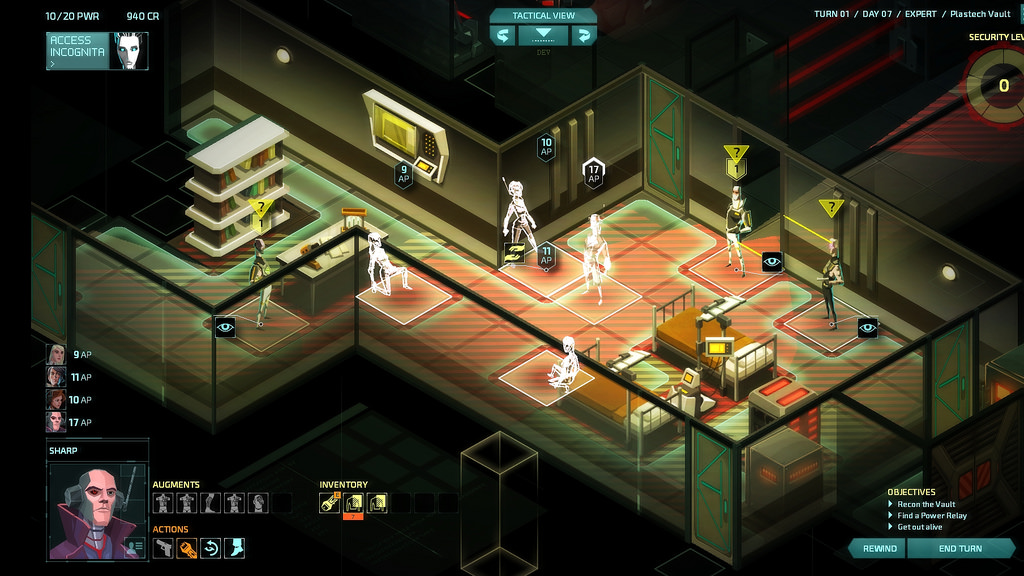
Invisible Inc, one of the best and only turn based infiltration game.
TLDR
I asked several other moai devs about why they had chosen moai, and here are their answers:
MOAI TODAY
- It is open source, so you don't have to wait for someone else to fix the bugs that might be stopping you, and you can optimize whatever part of the engine you like. Moai is also free, and all you need to do is credit the engine, either in your splash screen, or in the credits. It also allows you to add features at the engine level.
- lua is awesome to work with. fast, lightweight, with a good C API. And the code written by other is very readable.
- It is easy to get into. You have very little setup to do before running.
- It is also natively made for 2D.
Rumors of moai's death have been greatly exaggerated: It is still actively maintained by its original creator, and several dedicated community members. A version 2.0 will be out "soon" and is currently in testing stage. It is a shame that the main site for moai is terribly outdated, though, which does not really help showing how active the (small) community is. So there is no reason not to try it if you want an efficient open source 2D engine.
The "only" drawback is its small userbase, and the resulting lack of something like the Unity Asset Store. There are also less tutorials, but the ones that exist should be enough to get you started, and moai ships with quite a lot of samples that can help you get started with a given feature.
So it is better suited to people who like to work close to the metal, and want the flexibility to make changes to the engine, or just have a look at it.
And if you still have questions about the way some function works, you can just read the sourcecode, which I have found very well organized and readable. Unlike what the former punchline would make you think ("moai, the mobile platform for pro developers"), it is very suited to PC gaming (Invisible Inc and Broken Age were first made for PC), and works very well even if you don't plan to make a living out of game development.
WHERE TO GET STARTED?
The first step should be to get the binary: The historical home page of moai is not where you should look at. moaiforge is updated more often, and contains good resources on getting started with moai: 1.7.5 is the version you should download. You can get it here for windows and MacOSX. If you want the linux version, I cannot help you much as I have not worked with the linux version for quite some time.
Just unzip the windows file, go to The rocket lobster tutorial. It should have everything you need to keep your game going.
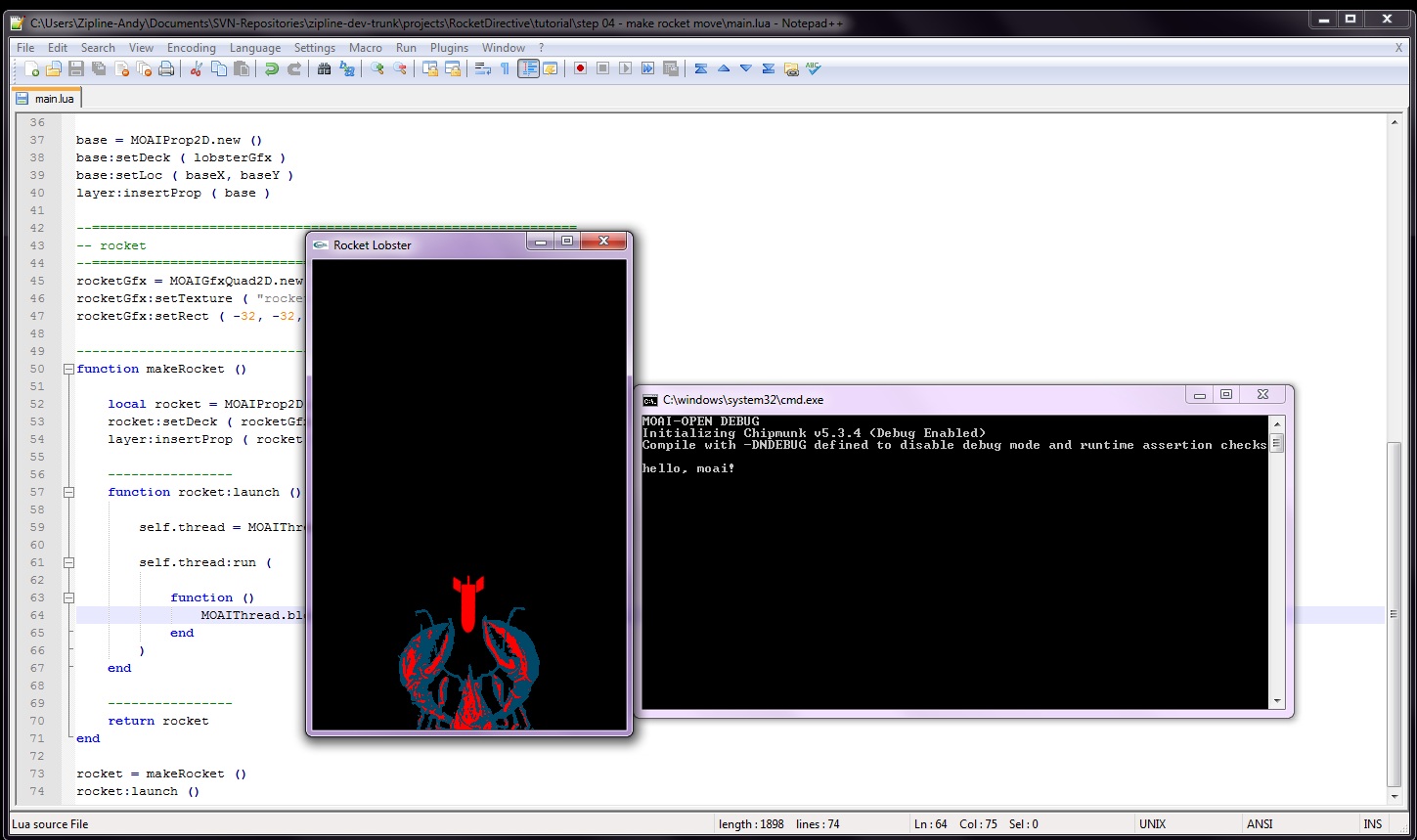
The tutorial should walk you through getting a lobster to send missiles
Note that instead of adding moai to your system PATH, you can just copy moai.exe from moaisdk-windows-1.7.5bin to the unpacked rocket lobster folder, and create an empty lobster.lua file, and lobster.bat file with the following line:
moai.exe lobster.lua
And voila, you are set. Just write the content of the tutorial in lobster.lua and it would work. Alternatively, you can use the existing main.lua file, and put:
moai.exe main.lua
in lobster.bat if you don't want to rewrite it yourself.
DIVE INTO MOAI
You should try the basic prop animation tutorial if you want to follow another tutorial. You can also read about moai basic features on the same site.
There is also a very nice serie about moai on this website. They are old, but they should still work with the latest version of moai.
To go deeper, I strongly recommend you to browse through moai samples. This allows you to edit them and immediately see the results with moai web host. They cover a lot of different topics.
There is a simple exemple of sprite animation for instance. You can also dig into your moai samples folder, and get the same samples: Its location is
moaisdk-windows-1.7.5\moaisdk-windows-1.7.5\sdk\moai\samples
You should also check moaisnippets which contains a lot of working exemples to guide you. You can then copy paste the exemples to moaifiddle.
moaifiddle allows you to write and execute code for moai online, like the moaiforge player abouve, so you can copy paste any of the exemples to modify it at your convenience, or start from a blank page, and test them online.
And if you need some help with lua, the main resources are the 5.1 Reference Manual and The book Programming in Lua, but the online version is for lua 5.0.
To get help about moai, you should browse moai forum, there is not much activity, but questions are answered pretty quickly, and the community is quite helpful.
If something is out of date or doesn't work, please send me a note here or on moai forum so that I update it.







